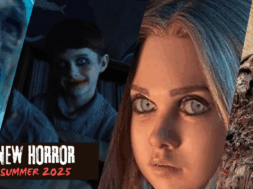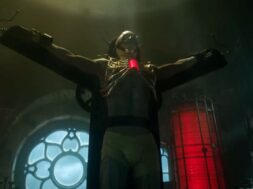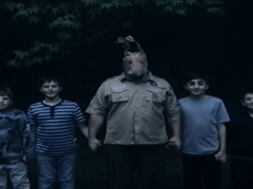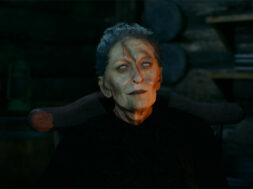In the long line of Stephen King adaptations, few have the prestige and fanfare of 1989’s Pet Sematary. It’s one of those films that works on many levels. It’s a great horror film, offering up the chills and thrills that we all love, but it’s also a wonderful story about family and the difficulties that accompany the loss of a loved one. Pet Sematary was also the first King film to be directed by a woman and remains one of the most influential horror films ever directed by a woman, making our top ten.
The cult of Pet Sematary is so grand that it inspired the documentary Unearthed & Untold: The Path to Pet Sematary, now available on Blu-ray courtesy of Synapse. The doc was directed by super-fans John Campopiano and Justin White. Campopiano and White took some time to answer some questions about their new film for Bloody Disgusting.
Do you remember your first experience with Pet Sematary? Was it the book or movie first? Did it resonate right away or was it something that grew over time?
John Campopiano: I saw the film before I read the book and–like many people–I was probably too young to be watching it. Pet Sematary was one of the earliest memories I have of feeling that exhilaration from being terrified. I was on the top bunk at a friend’s house watching a rented VHS copy with a small group of neighborhood kids. I would look away every so often but became glued to the screen at the first sight of Zelda. I was both scared and fascinated.
Justin White: I was 13 at the time, and I was up really late watching TV and Pet was on. I had no idea what it was, I hadn’t heard of the book yet. My parents weren’t thrilled about me watching horror films at that time so while I was fascinated by them, the opportunity to watch one was still rare, so I took it. I remember it being creepy in a much different way than some of the other films I’d seen by then in the sense that it lacked the Freddy Krueger/Jason Voorhees feel to it. You weren’t really on the edge of your seat, you just had this overall sense of uncomfort with it. I remember watching the scene when Jud tells Louis the story about how his dog came back from the dead. When the dog appeared on screen growling and barking and you could see the blood all over his face, I think I had to hide my eyes and cover my ears, I was not expecting that. But despite the fact that it wasn’t a slasher and affected me differently than one, to me it was still just a really cool horror movie, nothing more.
Like most horror films, when you look beyond the gore and scares within Pet Sematary there are some pretty heavy themes on handling grief and loss. Do you think that attributes to the film’s lasting impact?
JC: It’s a good question. I think the overly personal and emotional plot points of Pet Sematary certainly separates it from other popular horror films of the era, like A Nightmare on Elm Street. and Friday the 13th. That’s not to say it’s better than those films, but Mary was clearly more interested in exploring how humans cope with loss and less so on gore and shock. One thing that’s worth mentioning is that a lot of people have several different relationships with Pet Sematary depending on where they are in their lives. For example, we often heard people say things like, “I used to watch this film a certain way before I had children. After I had children, I either watched the film in a very different way or I couldn’t watch it anymore period.” It seems for a lot of people their relationship to the film changes once they start building a family. How many other horror films have that sort of impact?
JW: I do. Like I said before, it’s not a slasher. It deals with real human emotional responses to death and puts the viewer in the driver’s seat by essentially causing you to ask yourself what you would do in that type of situation. These themes are timeless. I think people can really connect with the film at different stages of life. When they’re young, as I was when I first saw it, it’s kind of like a roller coaster ride, uncomfortable/scary and a lot of fun. But when they’re older and have kids of their own, the film hits much closer to home, and they understand it’s core meaning a lot more and can appreciate it on a grander scale.
When I first saw the film I was 5 or 6 and I really enjoyed watching reruns of The Munsters. Seeing Fred Gwynne for the first time as someone other than Herman Munster was a shock to the system. Did you undergo something similar?
JW: I only knew Fred from the few other 80s films I’d seen him in. Despite that though, he did have much more of a presence in that film than one would expect. Every scene he was in, your focus was on Fred. I guess that was because most people I’m sure could better relate to the Creed family, in that there was more familiarity in general with them. But Fred was the different one, the one who spoke in the thick accent and had all those off-the-wall ways about him. So while I didn’t know him yet as Herman Munster, his character in Pet certainly commanded my attention.
JC: When I saw the film as a kid I never made the connection that the actor playing Jud was also the actor who played Herman Munster. I think that’s a testament to Fred and the ability he had to play just about anything. He could dance, sing, draw, do comedy, play it serious–he was creative force. The world lost him far too soon.
Pet Sematary is directed by Mary Lambert. When I was younger I didn’t know anything about directors but as I grew older and became aware of how the world works I started to realize the significance of the film being directed by a woman and that made the movie more special in my eyes. The film being directed by a woman, did that factor into your decision to make this doc to champion the film?
JC: Mary being a female director played no part in our decision to pursue a documentary about Pet Sematary. That being said, we were always aware of how significant it was for a female to be in the director role, particularly for a horror film and in the 1980s. It’s just another example of why Pet Sematary stands out a bit: there weren’t many females working in that high of a position in the film business. Over the years as we absolutely grew to appreciate the significance of what she accomplished in what was (and still is) a male-dominated industry.
JW: While it wasn’t part of our decision to make the doc, it certainly was a factor we decided to explore and showcase in it. It’s true that most horror films of the time were directed by males so seeing one through the eyes of a female definitely gave it a different feel. I think perhaps more emphasis was placed on the family aspect of the story, thereby allowing the viewer to relate more when the time came for Gage’s death. Pet Sematary I think has always been a film that’s been different than most in the sense that it allows the viewer to grieve with the Creed family. Most films, they show the death and that’s it, they move on. Pet does it differently, it holds on the aftermath of the death and the grief period that follows. I don’t know that if the film had been directed by a male that we would’ve had that opportunity and ultimately a better understanding of the meaning of the story.
Growing up how many dead pets did you bury hoping they’d come back to life?
JC: The only pet I buried and wished would come back was a little frog named Jethro. I accidentally killed him and so, if nothing else, I wanted him to come back to life so that I could apologize.
JW: I’m happy to say that I never buried an animal, ever.
Where does Pet Sematary rank in comparison to other King adaptations?
JC: I think Pet Sematary is one of the stronger adaptations in the Stephen King catalogue. One of the primary reasons I say this is because it was actually filmed in the areas King often writes about. Prior to Pet Sematary, King’s films were often set in Maine but shot elsewhere, such as the Pacific Northwest. That Pet Sematary was filmed in King’s home state makes it a significant adaptation just on those grounds alone. I also think that, in particular, the first two acts of the film are some of the most effective moments of film from any of his adaptations. Mary didn’t hold back in terms of showing the grief and ratcheting up the tension. Gage’s funeral–maybe even more so than his death scene–was really unlike anything else we were seeing in horror films during that era. It’s not a perfect film but I think it ranks highly on the (long!) list of Stephen King adaptations.
JW: Believe it or not, I haven’t seen a good portion of the King adaptations. There are certainly the more well-known ones that I’ve seen like It, Shining, Misery, etc. but there’s a lot I’ve yet to see, so for me, Pet Sematary ranks right up at the top. It’s a well-made film with a fantastic story, great acting and really good special effects for its time.
Does this film have the greatest theme song of all time? The answer is yes, I just want the experts to confirm.
JC: It’s definitely a great theme! So catchy and perfect given that King wrote The Ramones into the novel. That song is also a nice contrast to Elliot Goldenthal’s moody, sentimental score. Don’t get me wrong, I LOVE what Elliot brought to the film but The Ramones felt very true to both King and also Mary Lambert who was no stranger to the world of music and music videos.
JW: I place myself on the list of those who really love the Ramones’ song “Pet Sematary”. I know some consider it cheesy, but what can I say.. always loved it.
You can order Unearthed & Untold directly through Synapse today!










